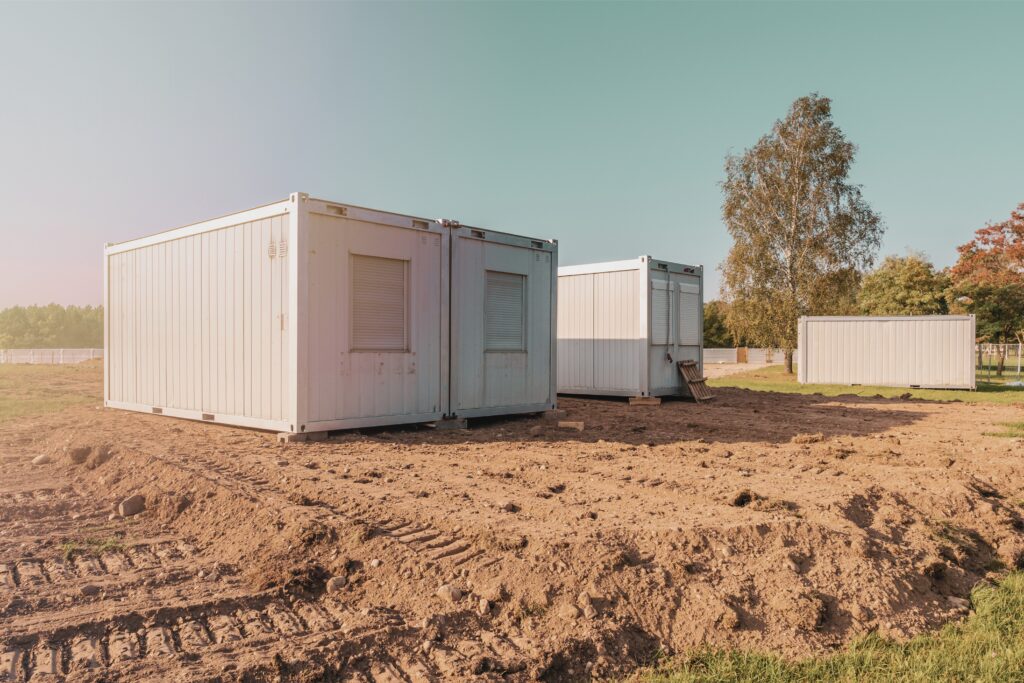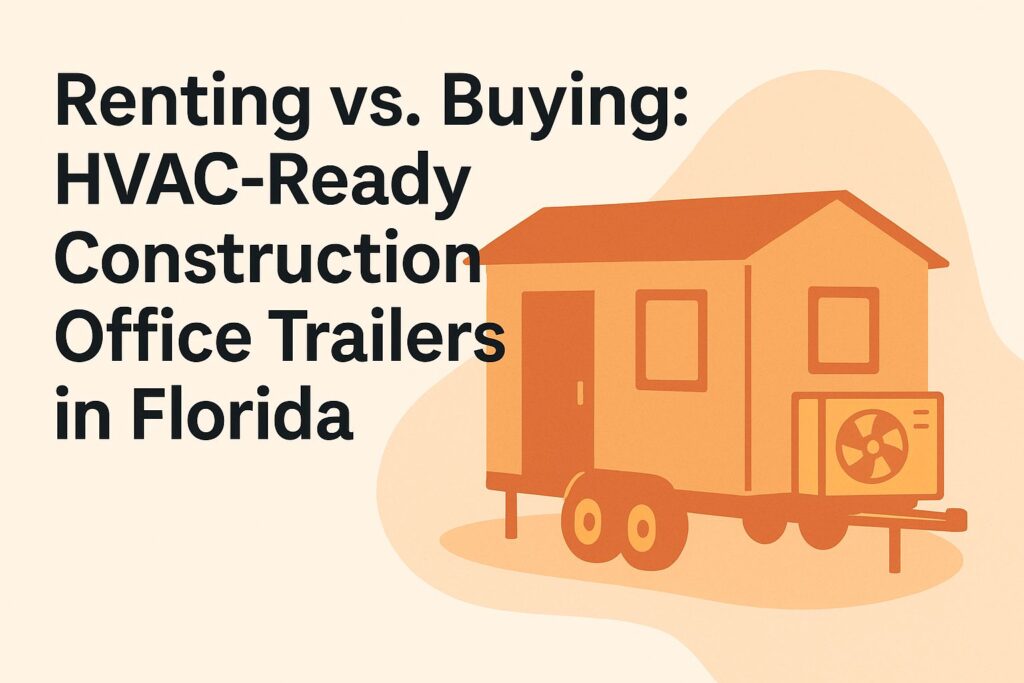
Renting vs. Buying: HVAC-Ready Construction Office Trailers in Florida
Florida’s heat wave strikes your construction site. Without solid cooling that follows the rules and gets the required permits, your workers lose their concentration. You’re swamped with deadlines, but your office trailer’s HVAC system could make a big difference-or cause major problems. In Florida’s booming build scene, HVAC-ready trailers and mobile offices keep you compliant and cool. Look at their long-lasting features, the pros and cons of renting versus buying, a cost comparison, challenges with humidity, and tips for making good decisions to choose the right option for your projects.
Overview of HVAC-Ready Construction Office Trailers
HVAC-ready construction office trailers and portable offices, like the 12×40 ft models from Trailers USA with pre-installed 13.5k BTU air conditioning units, provide instant climate control workspaces for 4-6 workers on job sites.
When selecting one, you get ductless mini-split systems from Mitsubishi including heating, ventilation, and air conditioning boasting 20 SEER efficiency for optimal energy use, integrated electrical panels with 50-amp service to power tools and lights, and insulated steel walls rated R-11 for durability. These trailers keep indoor temperatures between 68 and 78 degrees Fahrenheit to meet ANSI/ASHRAE Standard 55 for thermal comfort, no matter the outdoor heat or cold.
Key specs include:
- size options and floor plans ranging from 8×20 to 12×60 ft to fit any site with accessibility features;
- HVAC capacity of 10k-24k BTU for varying climates;
- standard features like LED lighting, furniture accommodations, vinyl flooring, pre-wired outlets and internet, and locking doors.
Setup and installation takes just 4-6 hours post-delivery-level the trailer, make utility connections, and you’re operational.
Relevance to Florida’s Construction Sector
In Florida’s booming local market for construction, where projects in Miami and Orlando grew 15% in 2023 per U.S. Census Bureau data, you rely on HVAC-ready trailers to keep teams productive amid 90 degreesF heat indices.
You need these temporary structures such as trailers for blueprint storage and on-site meetings, especially on Tampa’s high-rise builds where space is tight.
The 2023 Associated Builders and Contractors report provides market analysis highlighting 12,000 new jobs, fueled by tourism and real estate surges.
For instance, a $2M Orlando project deployed three 12×40 ft trailers, supporting 200 worker-days without heat-related delays.
To optimize, follow these three tips:
- match trailer size to crew and business needs (e.g., 200 sq ft per five workers);
- connect with project timelines and project duration (6-18 months for setup and rotation);
- schedule bi-weekly HVAC checks.
Ultimately, they reduce downtime by 25%, ensuring scalability and steady progress.
Key Features of HVAC-Ready Construction Office Trailers

You demand modular buildings such as trailers that withstand Florida’s elements while keeping your site office cool-features like galvanized steel framing and 16k BTU HVAC units in models from Eagle Leasing set the standard. Explore buy, rent, or lease options for these Florida mobile office trailers to find the perfect fit for your needs.
Standard HVAC Integration and Efficiency
Standard HVAC in these trailers features Carrier 14k BTU rooftop units with digital thermostats, achieving 18 SEER ratings to maintain 72 degreesF indoors during Florida’s 95 degreesF summers.
For better energy savings and sustainability, switch to a Trane variable-speed unit with 20-22 SEER ratings. It cuts monthly energy use from 800 kWh to 500 kWh in a 300 sq ft area, reducing environmental impact.
You connect the pre-wired Trane system to your trailer’s 30-amp breaker in under 2 hours, ensuring ENERGY STAR certification for up to 30% savings per DOE standards and green building practices.
A Tampa RV park reports $200 monthly utility reductions versus non-HVAC setups, based on customer testimonials and reviews.
Customize with these tips:
- Add zoning dampers ($500) for room-specific control and retrofits;
- Use thermostats like Nest ($250) to set schedules with a phone app;
- Install UV air purifiers ($300) to combat humidity;
- Choose low-VOC insulation upgrades ($400) that are eco-friendly and solar ready to improve thermal retention.
Durability for On-Site Use in Harsh Conditions
Built with 14-gauge steel and epoxy-coated frames, these trailers from WillScot endure 120 mph winds and resist rust in salty coastal air of Southeast Florida, lasting 10+ years on active sites.
To maximize stability, you anchor them using 4-point concrete tie-downs rated for Florida Building Code (FBC) wind loads and safety standards, ensuring secure placement in high-risk zones.
Key durability features include:
- Hurricane-rated windows compliant with Impact Zone standards
- Rubberized roofing that’s UV-resistant and waterproof
- Elevated chassis providing 6-inch ground clearance against flooding
- Reinforced doors with deadbolts for storm security
- Galvanized undercarriage to prevent corrosion
An Orlando contractor’s WillScot trailer survived Hurricane Ian in 2022 intact, per local reports and case studies. For upkeep, schedule annual corrosion checks with maintenance costs about $150.
These meet ASTM E1996 specifications for impact resistance and come with warranties and service agreements, lasting 40% longer than standard units, providing a solid return on the durability investment.
Renting HVAC-Ready Trailers: Pros and Cons
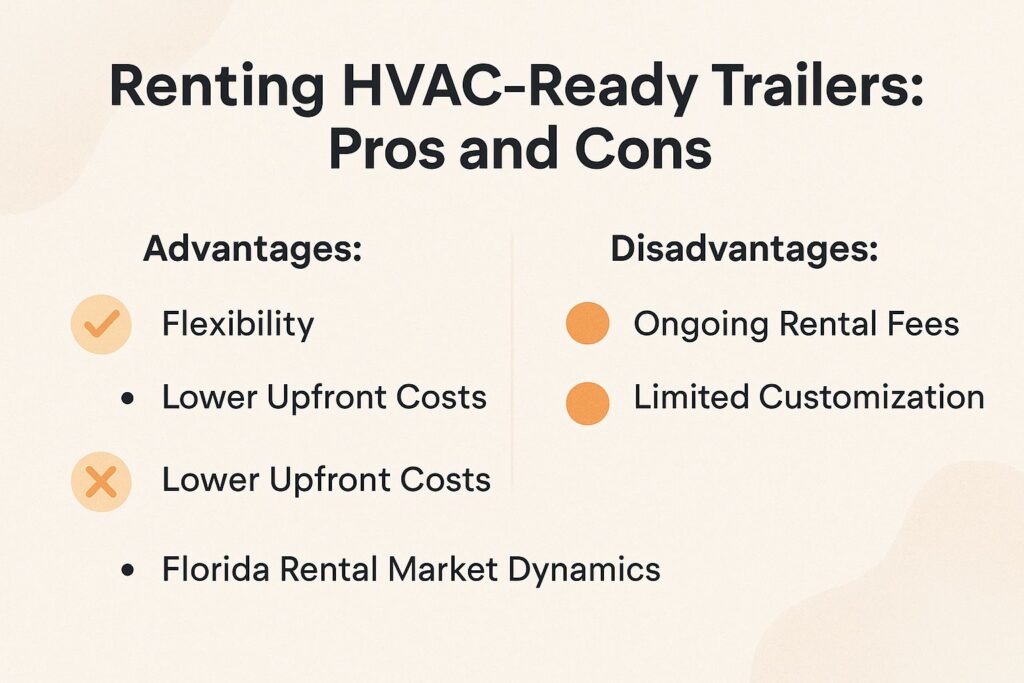
Renting lets you secure a 10×20 ft HVAC trailer from United Rentals for $400/month with delivery and transportation included, offering rental flexibility and quick scalability for short-term Florida projects without tying up capital.
Advantages: Flexibility and Lower Upfront Costs
You avoid $12,000 upfront by renting a trailer from Pac Van for $350/month, gaining the flexibility to relocate it mid-project to new Orlando sites in just 1 day.
This approach saves 80% on initial outlay compared to buying, allowing quick adaptation to job demands. Consider a Miami contractor who scaled from one to three trailers in six months, accelerating project starts by 50% through easy relocations.
Breakdown of lease agreements includes zero down payment, free delivery within 50 miles, and insurance coverage starting at $50/month. Recoup costs in 18 months for typical one-year projects, per ELFA data showing 15% annual rental growth in construction.
Maximize flexibility with these tips:
- negotiate three-month minimums for discounts,
- schedule relocations and dismantling during off-peak hours to cut fees,
- and pair with modular designs for seamless site swaps.
Disadvantages: Ongoing Rental Fees and Limited Customization
Ongoing fees can add up-renting a 12×30 ft unit from Boxabl at $600/month totals $7,200 yearly, potentially exceeding purchase costs after 2 years, while custom paint jobs cost extra $1,000.
Beyond these, renting modular units poses three key challenges.
- First, cumulative costs often surge, like $10,000 over 18 months versus $15,000 to buy outright in comparisons.
- Second, customization limits restrict permanent adds, such as plumbing fixtures, requiring temporary workarounds.
- Third, contract locks impose early termination fees up to $500.
To counter this,
- shop for quotes and rates aiming for under 1% of your project budget
- negotiate add-ons via riders for extras like $200/month utilities.
A Tampa firm overpaid $3,000 due to poor negotiation; learn from the Consumer Financial Protection Bureau’s reports on lease pitfalls.
Use these strategies to cut fees by 15%, saving thousands long-term.
Florida Rental Market Dynamics
Florida’s rental market sees 20% higher demand in summer per Sunbelt Rentals data, with average rates at $450/month for HVAC trailers in high-growth areas like Tampa.
You handle seasonal increases where Miami rates rise 25% during high tourism periods. Key suppliers like United Rentals, with over 50 locations statewide, dominate the market amid 10% YoY growth driven by construction surges, per FDOT reports.
Compare this to Orlando’s more affordable $400/month versus coastal areas at $550/month, as noted in the 2023 IBISWorld report on portable building rentals.
To optimize, follow these four tips:
- book 30 days ahead for 10% discounts;
- factor in hurricane season premiums adding 15%;
- negotiate multi-unit deals for volume savings;
- and inspect units on-site to check that they follow local codes.
Buying HVAC-Ready Trailers: Pros and Cons
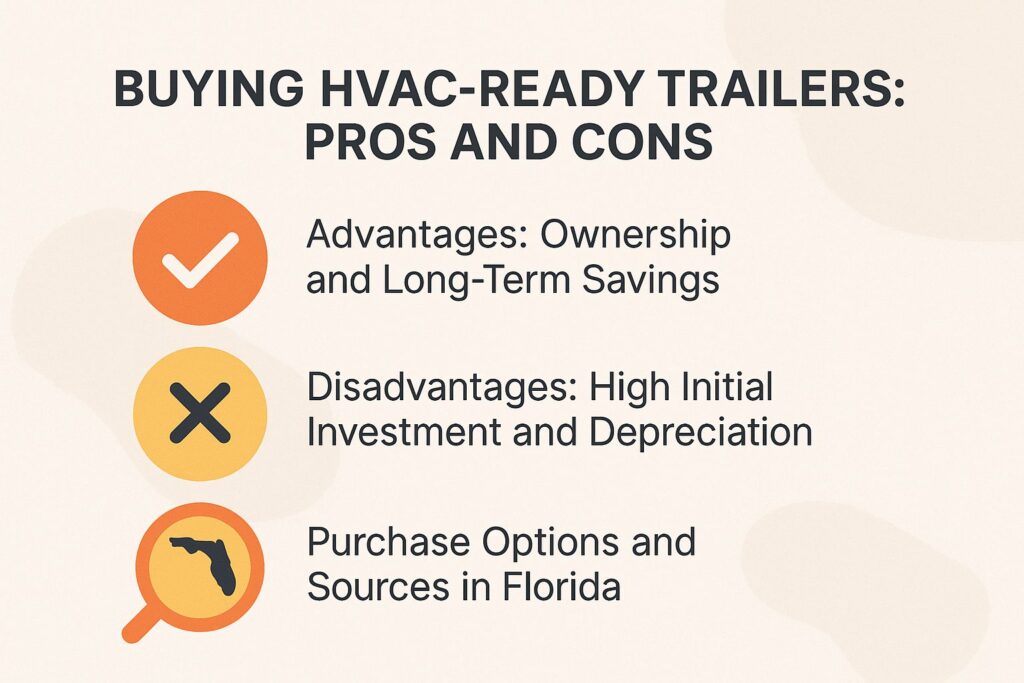
Buying as a key purchase option, a new 14×40 ft HVAC trailer from Mobile Mini for $18,500 gives you full control and equity buildup over rentals’ endless fees. If interested in weighing buy, rent, or lease paths for similar setups, our Florida Mobile Office Trailers: Buy, Rent, or Lease Options Explained breaks it down.
Advantages: Ownership and Long-Term Savings
Owning a trailer outright provides ownership benefits, saving you $5,000 annually after year 3, as seen with a Jacksonville firm reselling their unit for 70% value after 5 years with potential appreciation.
This stems from eliminating rental fees and interest, treating the trailer as commercial property allowing full control over customizations like reinforced shelving for tools, which boosted the firm’s efficiency by 25%.
For instance, an Orlando developer purchased two units for $30,000 total, saving $12,000 in fees over three years while adding branded interiors.
Key advantages include immediate equity buildup-resale values often hit $10,000-$15,000-and tax implications via IRS Section 179, offering up to 100% write-offs on qualifying equipment.
To maximize ROI, calculate a 25% return through depreciation.
Actionable tips:
- Finance at 4% APR to break even in 24 months;
- opt for used trailers from certified vendors like Trailer World for 20% savings;
- and secure commercial insurance to cut premiums by 15% with safety add-ons and liability coverage.
Disadvantages: High Initial Investment and Depreciation
The $20,000 sticker on a loaded HVAC trailer from Satellite Shelters hits hard upfront, with 10-15% annual depreciation eroding value to $12,000 in 3 years.
But practical plans can lighten the load. First, check lease-to-own lease agreements from companies like Satellite.
These spread the cost over 36 months with monthly payments of $550 to $700, which aids budgeting and cuts down on the need for a $15,000 to $25,000 payment right away.
To counter depreciation-peaking at 20% in year one per NADA guides-resell via Craigslist or eBay for 80% recovery, as Kelley Blue Book valuations confirm.
Tackle idle off-season costs ($500/year storage) by choosing covered facilities and insuring for $300 annually, covering 90% of risks like flood damage. A Miami buyer in Southeast Florida lost $4,000 uninsured in 2022 floods, highlighting insurance’s value.
Purchase Options and Sources in Florida
Top Florida sources include Trailers Direct in Tampa offering new units at $16,500 with warranties, or used from eBay sellers in Orlando or Jacksonville starting at $8,000.
To acquire quickly, follow these steps:
- Research dealers like WillScot (10 FL locations) via Better Business Bureau ratings for reliability.
- Compare prices-new units range $15,000-$25,000, used $7,000-$15,000-using sites like PKW Containers in Miami for custom options.
- Inspect trailers with VIN checks through Carfax ($40/report) to verify condition.
- Negotiate 5-10% off list price, aiming for under 1-2 weeks total.
For quick comparison:
| Dealer | Location | Price Range | Pros |
|---|---|---|---|
| Trailers Direct | Tampa | $16,500 new | Warranties, financing |
| WillScot | Statewide | $15k-$25k | Multiple sites, rentals |
| PKW Containers | Miami | $7k-$15k used | Custom builds |
Financial Comparison: Renting vs. Buying
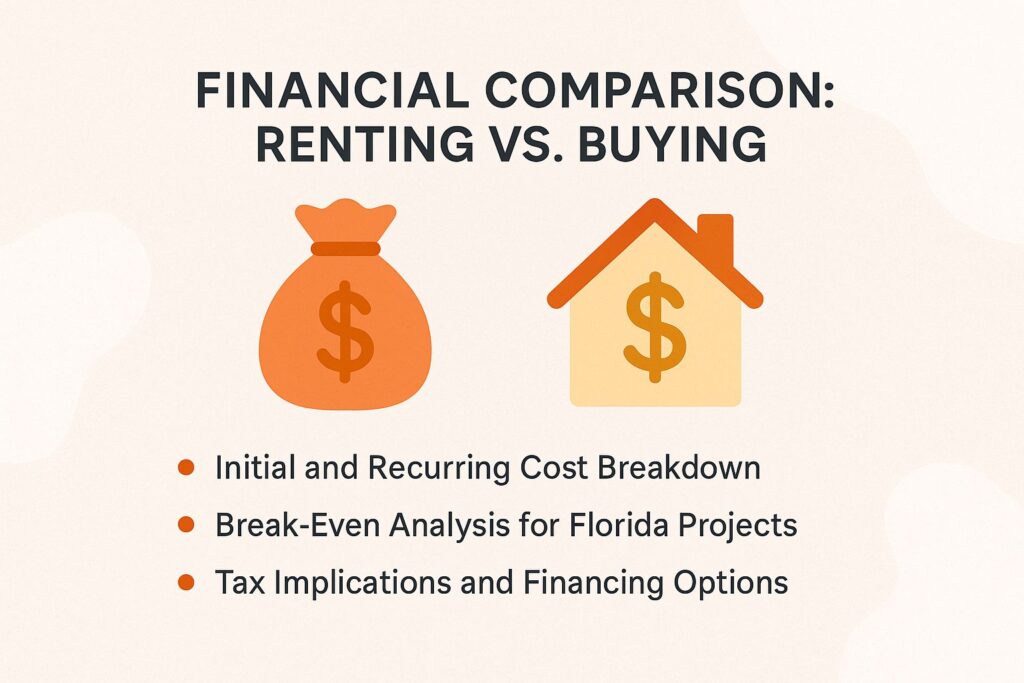
Comparing renting at $500/month to buying for $18,000 reveals a break-even at 36 months for typical Florida projects, per simple cash flow models.
Initial and Recurring Cost Breakdown
Initial renting costs you $500 deposit + $400 delivery, while buying demands $18,000 + $1,200 setup; recurring hits $450/month rent vs. $200/year maintenance ownership.
| Category | Rent | Buy |
|---|---|---|
| Initial Costs | $900 (includes insurance at $100/mo) | $19,200 (plus $300/mo financing at 5% APR) |
| Recurring (Year 1) | $5,400 | $2,400 |
| Total 12-Month Project | $6,300 | $20,000 (depreciates over 5 years) |
Rent suits short-term needs like seasonal FL shipping, avoiding ownership risks. Buying builds equity for long-haul operations.
Model scenarios in QuickBooks to forecast cash flow-add 10% contingency for unexpected repairs.
Budget tips:
- Negotiate bulk rent discounts;
- Deduct maintenance under IRS Section 179;
- Compare via Excel amortization tables for break-even analysis at 24 months.
Break-Even Analysis for Florida Projects
For a 24-month Tampa project, your break-even on a $17,500 purchase vs. $450/month rent occurs at month 39, factoring 7% annual inflation and potential cost savings.
To determine this, follow these steps for actionable analysis:
- Calculate annual costs: Rent totals $5,400/year; ownership includes $17,500 upfront plus $300/year maintenance/insurance.
- Apply the formula: Break-even months = Initial Purchase / (Annual Rent – Annual Ownership Costs). Here, $17,500 / ($5,400 – $300) 33.7 months base.
- Adjust for Florida’s 6% sales tax on purchase ($1,050 added) and 7% inflation (escalating rent to ~$483/month by year 2).
For your 24-month project, renting achieves cost savings of ~$2,800 overall since break-even exceeds duration.
Use Excel: Input costs in cells A1:B3, formula in A4: =A1/(B1*12 – B2).
Reference Harvard Business Review’s 2019 study on lease-vs-buy, showing buy favors projects over 36 months, saving up to 20% long-term in high-inflation areas like Tampa.
Tax Implications and Financing Options
Buying qualifies you for $10,000 Section 179 deduction in year 1, while rentals deduct as operating expenses; sign contracts to finance via 4.5% loans from Wells Fargo up to $50k.
You use IRS rules to reduce costs.
For renting, deduct 100% of monthly payments as operating expenses, streamlining cash flow without long-term commitments. Buying allows depreciation over 5-7 years using MACRS, plus a 20% bonus, potentially saving thousands-e.g., deduct $3,500 on an $18k purchase (see IRS Pub 946).
Expand financing with SBA 7(a) loans at 3-5% rates for up to $5 million or vendor financing at 0% for 12 months.
Boost savings through four strategies:
- Negotiate 2% fee cuts on leases for immediate reductions;
- Bundle equipment buys for higher Section 179 limits;
- Use energy-efficient upgrades for additional credits under IRC Section 179D;
- Refinance existing debts to lower rates, freeing up $1,000+ annually.
Florida Weather-Specific Environmental Factors
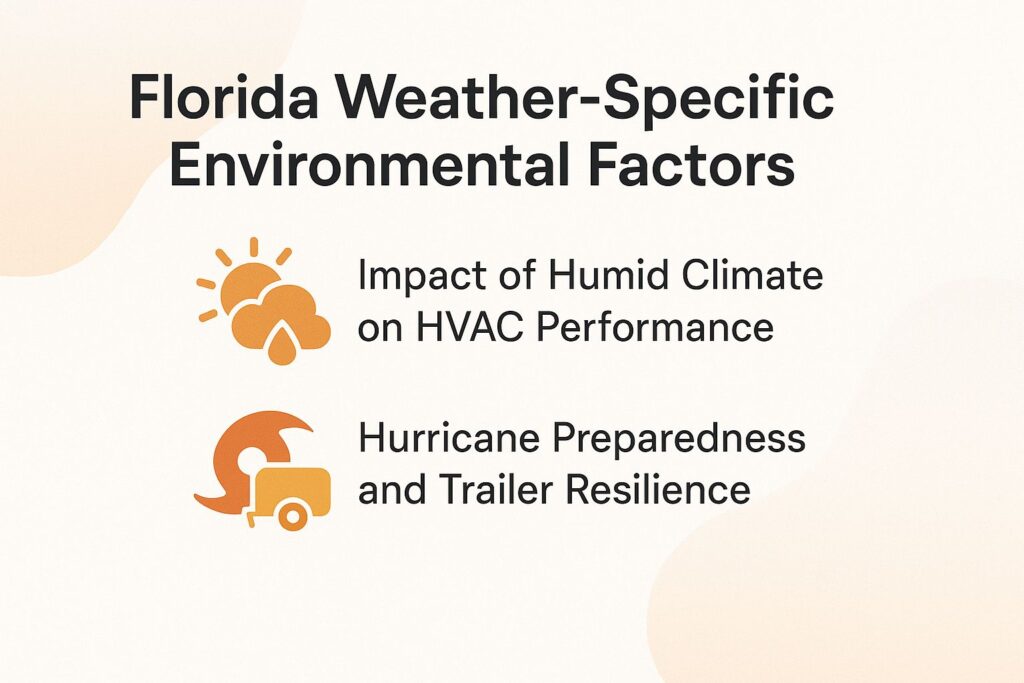
Florida’s 80% average humidity and frequent hurricanes demand HVAC trailers with dehumidifiers and wind-rated designs to protect your operations year-round, differing from permanent structures that often struggle with such conditions. This is why many Florida businesses are turning to mobile office rentals over permanent ones for better resilience.
Impact of Humid Climate on HVAC Performance
In Florida’s 75-90% humidity, standard HVAC units like LG 12k BTU models lose 15% efficiency without add-on dehumidifiers, spiking energy bills to $150/month.
To combat this, integrate a 50-pint/day dehumidifier like the Frigidaire FFAD5033W1 ($250), which reduces indoor humidity to 50%, boosting HVAC efficiency by 20-30% per ASHRAE Standard 169 guidelines.
Pair it with a Nest Learning Thermostat ($249) for automated control, targeting 45-55% relative humidity to cut mold risk by 30%, as noted in EPA studies. In a Miami case, this setup dropped energy costs 25% annually.
For maintenance, follow these tips:
- Change filters bi-monthly ($20 each) to maintain airflow;
- Empty reservoirs weekly or use continuous drain hoses;
- Clean coils quarterly with vinegar solutions to prevent buildup, saving $50/year in repairs.
Hurricane Preparedness and Trailer Resilience
Hurricane-rated trailers from Stealth Steel use 150 mph anchors and elevated floors, surviving events like Ian in 2022 with zero structural damage on Fort Myers sites.
To maximize resilience, follow these five preparation steps:
- Install FBC-approved tie-downs using a $300 kit from Simpson Strong-Tie for wind resistance up to 180 mph.
- Raise units 18-24 inches using concrete blocks to reduce flooding, following FEMA’s recommendation.
- Seal all vents and doors with silicone caulk pre-storm to prevent water intrusion.
- Get full insurance with FM Global policies starting at $400 per year.
- Plan inland relocation if winds exceed 140 mph, budgeting $500 per trip via flatbed transport.
For instance, a Tampa logistics firm prepped four Stealth units this way, resuming operations in just two days after Hurricane Idalia in 2023. Reference FEMA’s P-361 guidelines for safe construction in high-wind zones.
Maintenance and Regulatory Considerations
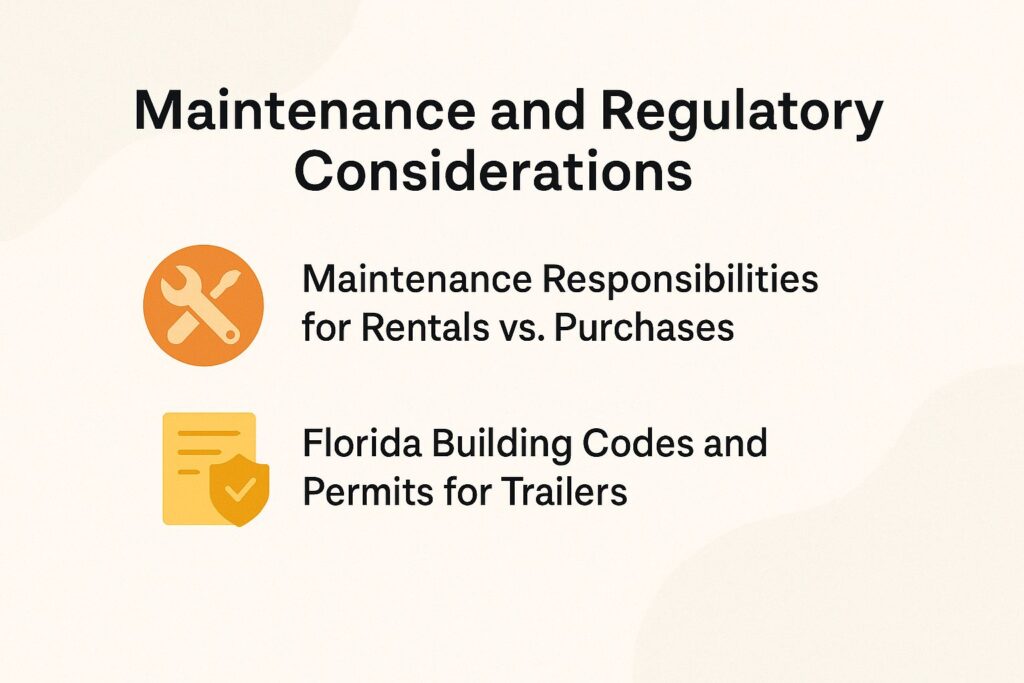
You balance upkeep and rules-rentals shift most maintenance to providers, but ownership means annual HVAC servicing at $250 to meet Florida’s strict codes.
Maintenance Responsibilities for Rentals vs. Purchases
Renters like you get provider-covered HVAC tune-ups twice yearly under Mobile Modular’s warranty, while owners handle $400 annual checks plus $100 filter replacements.
This setup keeps renters’ costs low-often just $0-50 monthly for basic cleaning supplies like vacuum attachments and mild detergent-while avoiding unexpected breakdowns. For example, Mobile Modular’s coverage recently prevented a $1,200 compressor failure for one tenant by addressing refrigerant issues proactively.
Owners can handle these steps themselves:
- replace filters every three months ($20-30 each through Amazon’s Subscribe & Save),
- clean condenser coils with a $25 garden hose kit, and
- seal ducts once a year with mastic tape ($15 from hardware stores).
Use apps like UpKeep to create schedules for maintenance.
This method can cut costs by $800 in the long run, using data from Trane’s 5-year warranty.
That data shows that doing maintenance early reduces repair costs by 20%, per EPA studies.
Florida Building Codes and Permits for Trailers
For compliance, Florida’s 8th Edition FBC requires wind-load certifications for trailers over 400 sq ft, plus $200 county permits for site placement in areas like Orlando, especially on construction sites.
To get through this process well, follow these steps:
- Verify zoning compliance first-commercial trailer use is permitted in about 80% of Florida counties, per local ordinances.
- Submit detailed plans to your Authority Having Jurisdiction (AHJ), incurring a $150 review fee; include engineer-stamped wind-load docs.
- Arrange electrical and HVAC inspections, typically completed in 1-2 weeks.
- For structures housing over 20 occupants, install ADA-compliant ramps, adding roughly $500 to costs.
The entire approval timeline spans 2-4 weeks. For instance, a 300 sq ft trailer in Tampa secured permits for $300 total (Florida Building Code Chapter 16).
Avoid pitfalls like skipping flood zone checks, which can trigger $1,000 fines from FEMA guidelines.
Decision Framework and Recommendations
Follow this rule: For projects longer than 24 months in humid areas such as Miami, purchase to save 35 percent. For shorter projects, rent from companies like Algeco to have more options.
Recommended steps: Use these 5 steps to make a decision.
- Assess duration and budget using an Excel model to project costs over time.
- Factor in Florida risks, like adding 10% for hurricane-proofing.
- Compare vendors by getting 3 quotes-e.g., Algeco rents at $2k/month, United Site Services at $1.8k.
- Calculate ROI; aim for >20% to favor buying.
- Talk to experts like NAHB advisors for advice that fits your situation.
Example: A firm in Orlando started by renting for $6,000 and grew its operations without any starting cash.
Reference McKinsey’s decision matrix for structured buy/rent analysis in Florida, especially in cities like Miami, Orlando, Tampa, and Jacksonville. Consider factors such as HVAC systems, energy efficiency, and Florida weather when evaluating ROI and negotiations. For personalized recs in Southeast Florida, opt for short-term rentals; for long-term, buy with financing to lock in savings.
About the Author
I’m John Keller, a University of Florida graduate with a bachelor’s degree in Business Management and the owner of Florida Used Construction Trailers. With over 12 years of experience in the industry, I’ve helped hundreds of Florida contractors—from Miami to Tampa—get the reliable jobsite offices they need to stay productive and profitable.

